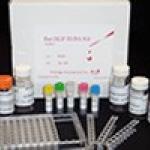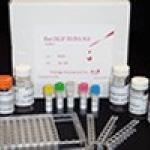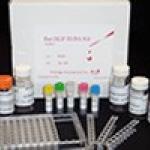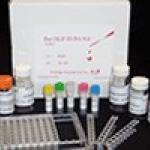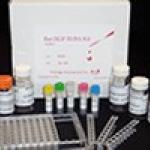-
Description:
Lamp-2 (lysosomal associated protein 2) has been demonstrated to be involved in the direct uptake of cytosolic proteins in lysosomes and also participates in the endocytic pathway. The protein is localized mainly to lysosomes; however, under certain conditions, it can also be detected in the plasma membrane. Interestingly, the level…
-
Description:
Lactate dehydrogenase (LDH) is an enzyme present in a wide variety of organisms, including plants and animals. LDH is found in the liver, kidneys, striated muscle, and heart muscle that catalyze the reversible conversion of pyruvate and lactate.It catalyses the interconversion of pyruvate and lactate with concomitant interconversion…
-
Description:
Lipoprotein(a) [Lp(a)] is an atherogenic lipoprotein particle formed by assembly of LDL particles and apo(a) bound to apoB-100 component of LDL . Apo(a) is the main constituent of Lp(a), has serine proteinase activity and is able of autoproteolysis . Apo(a) has 4548 amino acids, variable sizes from 200 to 700 kDa, multiple isoforms,…
-
Description:
The human P-Cadherin Kit is a sandwich ELISA. The capture antibody is a polyclonal human P-Cadherin antibody pre-coated onto the 96-well strip plates provided in the kit. Human test samples and standards of known P-Cadherin concentration are added to these wells and allowed to complex with the bound P-Cadherin antibody. A biotinylated…
-
Description:
Protein C inhibitor (PCI, SERPINA5) is a serine protease inhibitor (serpin) which limits the expression of protein C.Suzuki et al. (1987) determined the sequence of cDNA for human protein C inhibitor (PCI). A high degree of homology of the deduced amino acid sequence to that of other known inhibitors clearly demonstrated that protein…
-
Description:
PDGF AA is a member of the platelet derived growth factor family. The four members of this family are mitogenic factors for cells of mesenchymal origin and are characterized by a motif of eight cysteines. PDGF AA can exist either as a homodimer or as a heterodimer with the platelet derived growth factor beta polypeptide, where the…
-
Description:
Type I collagen is the most abundant form of collagen in the human body and is synthesized mainly by fibroblasts, osteoblasts, odontoblasts and chondroblasts. It is located in the extracellular matrix of many tissues of the body including cartilage, bone, tendon, skin and the sclera of the eye. Type I collagen is composed of two pro-…
-
Specification:96testDescription:
Type-II collagen is the basis for articular cartilage and hyaline cartilage.It makes up 50% of all protein in cartilage and 85-90% of collagen of articular cartilage.Type II collagen does form fibers. This fibrillar network of collagen allows cartilage to entrap the proteoglycan aggregate as well as provide tensile…
-
Specification:96TestDescription:
Type III Collagen is found co-localized with Type I Collagen in tissues, blood vessels and skin. Type III Collagen is a homotrimeric procollagen comprised of three identical pro a, (III) chains.1 Collagen III is important for the development of skin and the cardiovascular system and for maintaining normal…
-
Specification:96TestDescription:
Collagen type IV is a major component of basement membranes, such as those associated with capillaries and within glomeruli. It is composed of α1(IV) chain and α2(IV) chain in 2:1 ratio. It is a multimeric protein composed of 3 alpha subunits. These subunits are encoded by 6 different genes, alpha 1 through alpha 6…
 Description: Lamp-2 (lysosomal associated protein 2) has been demonstrated to be involved in the direct uptake of cytosolic proteins in lysosomes and also participates in the endocytic pathway. The protein is localized mainly to lysosomes; however, under certain conditions, it can also be detected in the plasma membrane. Interestingly, the level…
Description: Lamp-2 (lysosomal associated protein 2) has been demonstrated to be involved in the direct uptake of cytosolic proteins in lysosomes and also participates in the endocytic pathway. The protein is localized mainly to lysosomes; however, under certain conditions, it can also be detected in the plasma membrane. Interestingly, the level… Description: Lactate dehydrogenase (LDH) is an enzyme present in a wide variety of organisms, including plants and animals. LDH is found in the liver, kidneys, striated muscle, and heart muscle that catalyze the reversible conversion of pyruvate and lactate.It catalyses the interconversion of pyruvate and lactate with concomitant interconversion…
Description: Lactate dehydrogenase (LDH) is an enzyme present in a wide variety of organisms, including plants and animals. LDH is found in the liver, kidneys, striated muscle, and heart muscle that catalyze the reversible conversion of pyruvate and lactate.It catalyses the interconversion of pyruvate and lactate with concomitant interconversion… Description: Lipoprotein(a) [Lp(a)] is an atherogenic lipoprotein particle formed by assembly of LDL particles and apo(a) bound to apoB-100 component of LDL . Apo(a) is the main constituent of Lp(a), has serine proteinase activity and is able of autoproteolysis . Apo(a) has 4548 amino acids, variable sizes from 200 to 700 kDa, multiple isoforms,…
Description: Lipoprotein(a) [Lp(a)] is an atherogenic lipoprotein particle formed by assembly of LDL particles and apo(a) bound to apoB-100 component of LDL . Apo(a) is the main constituent of Lp(a), has serine proteinase activity and is able of autoproteolysis . Apo(a) has 4548 amino acids, variable sizes from 200 to 700 kDa, multiple isoforms,… Description: The human P-Cadherin Kit is a sandwich ELISA. The capture antibody is a polyclonal human P-Cadherin antibody pre-coated onto the 96-well strip plates provided in the kit. Human test samples and standards of known P-Cadherin concentration are added to these wells and allowed to complex with the bound P-Cadherin antibody. A biotinylated…
Description: The human P-Cadherin Kit is a sandwich ELISA. The capture antibody is a polyclonal human P-Cadherin antibody pre-coated onto the 96-well strip plates provided in the kit. Human test samples and standards of known P-Cadherin concentration are added to these wells and allowed to complex with the bound P-Cadherin antibody. A biotinylated… Description: Protein C inhibitor (PCI, SERPINA5) is a serine protease inhibitor (serpin) which limits the expression of protein C.Suzuki et al. (1987) determined the sequence of cDNA for human protein C inhibitor (PCI). A high degree of homology of the deduced amino acid sequence to that of other known inhibitors clearly demonstrated that protein…
Description: Protein C inhibitor (PCI, SERPINA5) is a serine protease inhibitor (serpin) which limits the expression of protein C.Suzuki et al. (1987) determined the sequence of cDNA for human protein C inhibitor (PCI). A high degree of homology of the deduced amino acid sequence to that of other known inhibitors clearly demonstrated that protein… Description: PDGF AA is a member of the platelet derived growth factor family. The four members of this family are mitogenic factors for cells of mesenchymal origin and are characterized by a motif of eight cysteines. PDGF AA can exist either as a homodimer or as a heterodimer with the platelet derived growth factor beta polypeptide, where the…
Description: PDGF AA is a member of the platelet derived growth factor family. The four members of this family are mitogenic factors for cells of mesenchymal origin and are characterized by a motif of eight cysteines. PDGF AA can exist either as a homodimer or as a heterodimer with the platelet derived growth factor beta polypeptide, where the… Description: Type I collagen is the most abundant form of collagen in the human body and is synthesized mainly by fibroblasts, osteoblasts, odontoblasts and chondroblasts. It is located in the extracellular matrix of many tissues of the body including cartilage, bone, tendon, skin and the sclera of the eye. Type I collagen is composed of two pro-…
Description: Type I collagen is the most abundant form of collagen in the human body and is synthesized mainly by fibroblasts, osteoblasts, odontoblasts and chondroblasts. It is located in the extracellular matrix of many tissues of the body including cartilage, bone, tendon, skin and the sclera of the eye. Type I collagen is composed of two pro-… Specification:96testDescription: Type-II collagen is the basis for articular cartilage and hyaline cartilage.It makes up 50% of all protein in cartilage and 85-90% of collagen of articular cartilage.Type II collagen does form fibers. This fibrillar network of collagen allows cartilage to entrap the proteoglycan aggregate as well as provide tensile…
Specification:96testDescription: Type-II collagen is the basis for articular cartilage and hyaline cartilage.It makes up 50% of all protein in cartilage and 85-90% of collagen of articular cartilage.Type II collagen does form fibers. This fibrillar network of collagen allows cartilage to entrap the proteoglycan aggregate as well as provide tensile… Specification:96TestDescription: Type III Collagen is found co-localized with Type I Collagen in tissues, blood vessels and skin. Type III Collagen is a homotrimeric procollagen comprised of three identical pro a, (III) chains.1 Collagen III is important for the development of skin and the cardiovascular system and for maintaining normal…
Specification:96TestDescription: Type III Collagen is found co-localized with Type I Collagen in tissues, blood vessels and skin. Type III Collagen is a homotrimeric procollagen comprised of three identical pro a, (III) chains.1 Collagen III is important for the development of skin and the cardiovascular system and for maintaining normal… Specification:96TestDescription: Collagen type IV is a major component of basement membranes, such as those associated with capillaries and within glomeruli. It is composed of α1(IV) chain and α2(IV) chain in 2:1 ratio. It is a multimeric protein composed of 3 alpha subunits. These subunits are encoded by 6 different genes, alpha 1 through alpha 6…
Specification:96TestDescription: Collagen type IV is a major component of basement membranes, such as those associated with capillaries and within glomeruli. It is composed of α1(IV) chain and α2(IV) chain in 2:1 ratio. It is a multimeric protein composed of 3 alpha subunits. These subunits are encoded by 6 different genes, alpha 1 through alpha 6…
